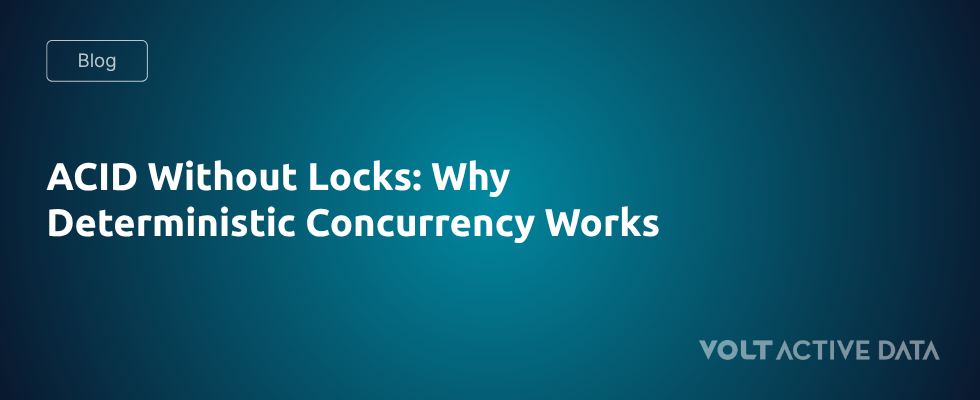Key Takeaways
- ACID compliance is crucial for applications requiring strong data guarantees, but traditional methods like locking and OCC can negatively impact performance.
- Deterministic Concurrency Control (DCC) offers a lock-free approach to ACID compliance, ensuring serializability and predictable performance.
- Traditional methods like 2PL, OCC, and timestamp-based protocols often suffer from blocking, aborts, and unpredictable latencies, especially under high contention.
- DCC pre-orders transactions deterministically, eliminating the need for locks, blocking, and retries, thereby achieving ACID guarantees and faster booking experiences.
- DCC provides benefits like zero lock contention, predictable throughput, and built-in serializability, making it ideal for real-time systems demanding both correctness and speed.
Table Of Contents
- Is your database truly ACID compliant—or just locked down by compromises?
- Why Lock-Based or Optimistic Models Fall Short
- Deterministic Concurrency Control: ACID Without Locks
- DCC vs. Traditional Methods
- Real-World Example: Flight Booking System
- What About Reads & Consistency?
- Why Determinism Beats “ACID-By-Validation”
- No Locks, But Not Free
- Final Thoughts
Is your database truly ACID compliant—or just locked down by compromises?
In the ever-evolving landscape of databases, ACID compliance remains the gold standard for applications in banking, travel, e-commerce, and telecom that demand strong guarantees on Atomicity, Consistency, Isolation, and Durability. Yet, how a database enforces these guarantees has a dramatic impact on its performance, scalability, and developer experience.
Most traditional and modern databases, including RDBMS and NoSQL systems, maintain ACID compliance by using locking, versioning, or retry-based validation methods. These techniques, while effective in ensuring isolation and correctness, often might do so at the expense of throughput and latency. In contrast, Deterministic Concurrency Control (DCC) offers a compelling alternative that guarantees full ACID compliance without the cost of locking, even under extreme concurrency.
Let’s explore why deterministic concurrency control is one of the best concurrency control mechanisms of high-performance transactional systems—and why it’s time to rethink how we achieve ACID.
Why Lock-Based or Optimistic Models Fall Short
Modern high-throughput databases often use one of the following techniques to ensure ACID:
- Strict Two-Phase Locking (2PL): Enforces serializability but introduces deadlocks and limits concurrency. Performance suffers due to blocking behavior.
- Optimistic Concurrency Control (OCC): Assumes conflicts are rare. Transactions proceed in parallel but may be aborted if conflicts are detected during commit, resulting in unpredictable latencies and throughput drops under high contention.
- Timestamp-based Protocols or MVCC: It maintains several versions of the same data using timestamps, which can require additional global coordination (timestamp counters) or substantial memory overhead to store the versions.
These techniques work—but come at a cost:
- Locks block transactions.
- Version checks and aborts waste compute cycles.
- Global coordination (e.g., timestamp allocation) can become a bottleneck.
- Latency is unpredictable, especially under write-heavy workloads.
When systems attempt to simulate ACID on distributed key-value stores or NoSQL engines, performance can decline. Even if they technically meet ACID requirements, predictability and throughput often suffer as a result.
Deterministic Concurrency Control: ACID Without Locks
Deterministic Concurrency Control (DCC) takes a radically different approach:
- All transactions are pre-ordered deterministically (often at submission time).
- Transactions are executed in the same order across partitions and replicas.
- With no locks, no blocking, and no retries, transactions commit reliably every time.
- The system achieves serializability by construction, not by detection.
DCC vs. Traditional Methods
| Benefit | Traditional Lock-Based / OCC | DCC |
|---|---|---|
| Locking Overhead | High | None |
| Deadlocks | Possible | Impossible |
| Transaction Abort Rate | High under contention | Highly under contention |
| Throughput | Unpredictable | Predictable + scalable |
| Replication | Complex coordination needed | Simplified due to deterministic order |
In other words, DCC achieves full ACID with zero lock contention and predictable performance.
Real-World Example: Flight Booking System
Consider a flight booking system with two users trying to book the last available seat:
sql
-- Transaction T1
BEGIN;
SELECT seat_count FROM flights WHERE flight_id = 'AI2025' FOR UPDATE;
UPDATE flights SET seat_count = seat_count - 1 WHERE flight_id = 'AI2025';
INSERT INTO bookings VALUES ('U123', 'AI2025');
COMMIT;sql
-- Transaction T2 (concurrent)
BEGIN;
SELECT seat_count FROM flights WHERE flight_id = 'AI2025' FOR UPDATE;
UPDATE flights SET seat_count = seat_count - 1 WHERE flight_id = 'AI2025';
INSERT INTO bookings VALUES ('U456', 'AI2025');
COMMIT;In a traditional system:
- These transactions will block each other using locks.
- Depending on timing, one may abort if OCC is used.
- Under contention (e.g., during fare sales), this can throttle the system, and users may face timeouts or booking failures.
With deterministic concurrency control:
- Transactions are pre-sequenced deterministically.
- No lock is needed; the system knows which will commit first.
- The database applies transactions serially, but at a high throughput, thereby eliminating uncertainty.
Result?: ACID guarantees. No retries. Fast booking experience.
What About Reads & Consistency?
Unlike MVCC systems that keep multiple versions, DCC-based systems don’t need to juggle old and new copies. Since every transaction is deterministically ordered:
- Reads are consistent with the transaction timeline.
- No need to re-validate read values at commit.
- No phantom reads. All transactions are serializable by design.
This makes it ideal for applications such as fraud detection, logistics, or stock trading, where milliseconds matter and data consistency is non-negotiable.
Why Determinism Beats “ACID-By-Validation”
Many NoSQL systems today have started offering ACID compliance by combining:
- OCC for reads
- 2PL for writes
- Version counters for consistency
But this hybrid model introduces:
- Overhead in managing locks and versions
- Increased aborts in multi-record or distributed transactions
- Unpredictable latencies under pressure
By contrast, deterministic systems such as Volt Active Data eliminate these issues:
Replicas remain consistent automatically because they apply the same transaction order.
Every transaction either succeeds or is never scheduled.
No coordination is needed at commit time—it’s already serialized.
No Locks, But Not Free
DCC provides significant benefits, including zero lock contention, predictable throughput, and built-in serializability. But in distributed environments, it does come with some operational trade-offs.
In Volt, DCC simplifies runtime execution but introduces some overhead during rare events, such as node rejoining. To maintain consistency, it relies on a task log to preserve transaction order, which must be replayed when a node catches up. This is a deliberate trade-off: reliable & predictable performance under normal conditions, with a small cost during recovery.
Final Thoughts
It’s Time for a Shift. It’s no longer enough to say your system is technically ACID compliant. The real question is:
Can it guarantee ACID without locking, without retries, and at scale?
Deterministic concurrency control is the solution for modern, real-time systems that demand both correctness and speed. As workloads scale and users expect sub-millisecond responsiveness, we must move beyond legacy techniques that rely on blocking, waiting, or aborting.
Take the time to validate whether your database employs a deterministic concurrency control mechanism or if it can outperform a database that uses such a mechanism.
With Volt Active Data, we are already helping companies achieve microsecond-level latencies with high concurrent workloads. Try it now.




